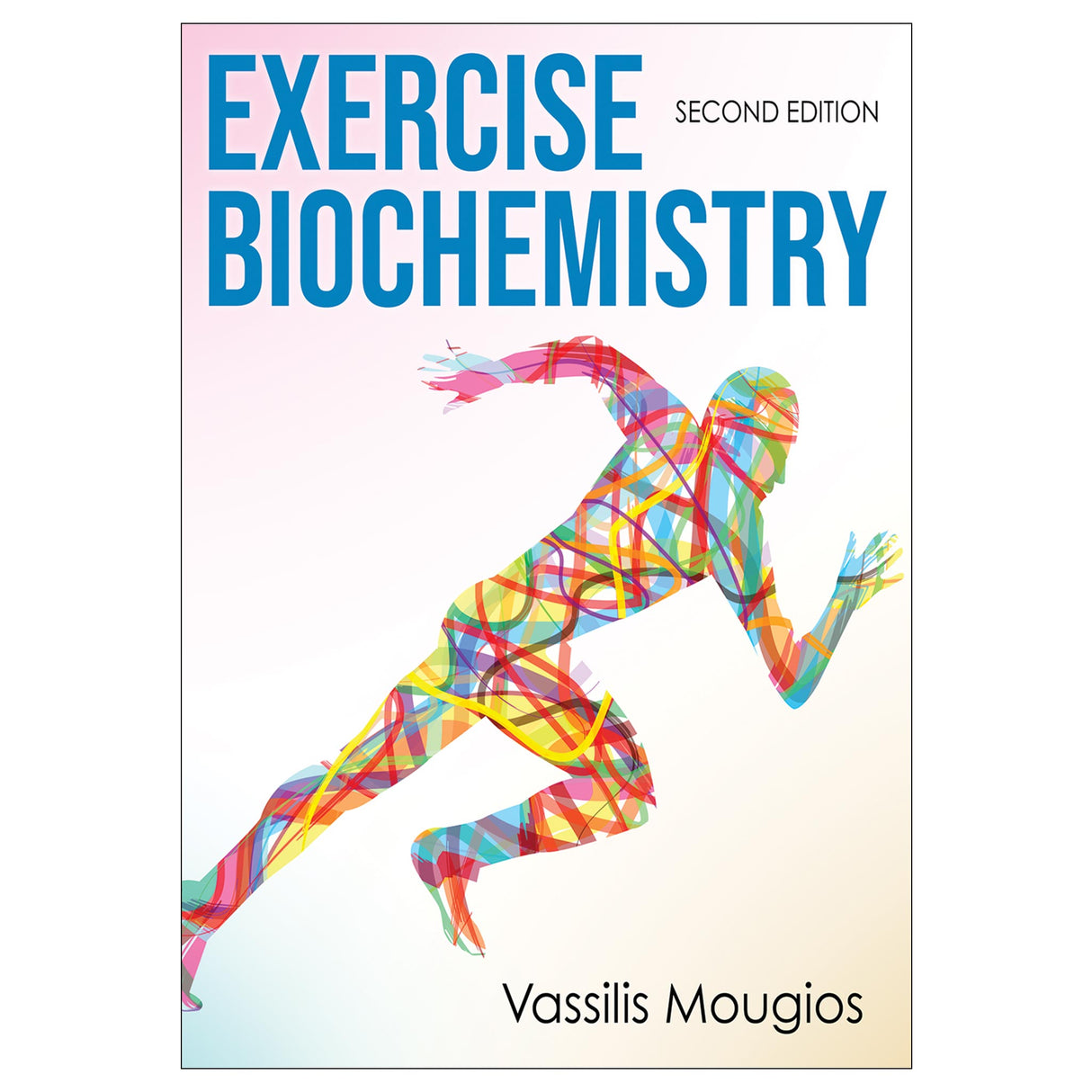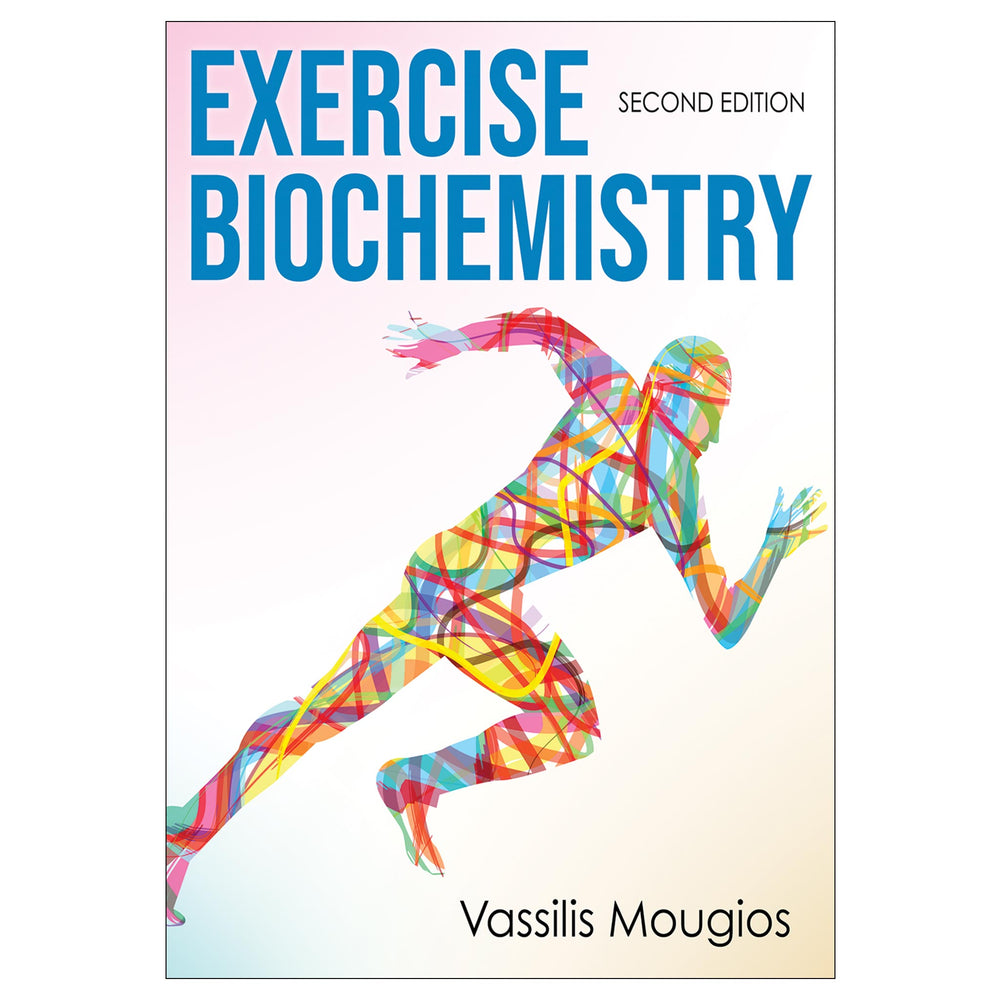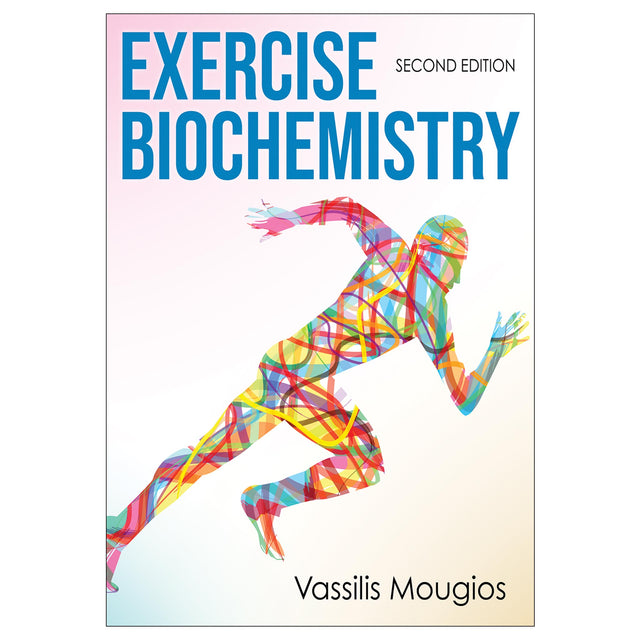Exercise Biochemistry 2nd Edition
Author: Vassilis Mougios
$99.00 CAD
Exercise Biochemistry, Second Edition, takes a potentially difficult and technical subject and translates it into a clear explanation of how exercise affects molecular-level functioning in athletes and nonathletes, both healthy and diseased. Extremely student friendly, this text is written in conversational style by Vassilis Mougios, who poses and then answers questions as if having a dialogue with a student. Using simple language supported by ample analogies and numerous illustrations, he is able to drive home important concepts for students without compromising scientific accuracy and content.
With significantly updated research, the second edition of Exercise Biochemistry offers a complete compilation, from basic topics to more advanced topics. It includes coverage of metabolism, endocrinology, and assessment all in one volume. This edition also adds the following:
• A chapter on vitamins and minerals present in the human diet
• An evidence-based chapter on exercise and disease that shows how appropriate exercise prescriptions can mobilize biochemical mechanisms in the body to fight obesity, cardiovascular disease, insulin resistance, diabetes, the metabolic syndrome, cancer, osteoporosis, mental disease, and aging
• Updated information on nucleic acids and gene expression, including exercise genetics, RNA interference, and epigenetics
• An examination of caffeine as an ergogenic aid to better demonstrate the relationship between caffeine and fatigue
• Up-to-date findings on how different types of exercise affect lipid metabolism and the use of individual fatty acids during exercise
To facilitate student learning, Exercise Biochemistry incorporates chapter objectives and summaries, key terms, sidebars, and questions and problems posed at the end of each chapter. It leads students through four successive parts. Part I introduces biochemistry basics, including metabolism, proteins, nucleic acids and gene expression, carbohydrates and lipids, and vitamins and minerals. Part II applies the basics to explore neural control of movement and muscle activity. The essence of the book is found in part III, which details exercise metabolism related to carbohydrates, lipids, and protein; compounds of high phosphoryl-transfer potential; effects of exercise on gene expression; integration of exercise metabolism; and the use of exercise to fight disease. Part IV focuses on biochemical assessment of people who exercise, with chapters on iron status, metabolites, enzymes, and hormones. Simple biochemical assessments of health and performance are also discussed.
Exercise Biochemistry, Second Edition, is an authoritative resource that will arm future sport and exercise scientists with a clear understanding of the effects of exercise on the function of the human body.
Audience
Text for undergraduate- and graduate-level courses in exercise biochemistry or a supplemental text to exercise physiology courses. Also a reference for exercise physiologists, exercise biochemists, sport nutritionists, and health scientists and biologists with an interest in exercise.
Part I. Biochemistry Basics
Chapter 1. Introduction
1.1 Chemical Elements
1.2 Chemical Bonds
1.3 Molecules
1.4 Ions
1.5 Radicals
1.6 Polarity Influences Miscibility
1.7 Solutions
1.8 Chemical Reactions
1.9 Chemical Equilibrium
1.10 pH
1.11 Acid-Base Interconversions
1.12 Buffer Systems
1.13 Classes of Biological Substances
1.14 Classes of Nutrients
1.15 Cell Structure
Chapter 2. Metabolism
2.1 Free-Energy Changes of Metabolic Reactions
2.2 Determinants of Free-Energy Change
2.3 ATP, the Energy Currency of Cells
2.4 Phases of Metabolism
2.5 Redox Reactions
2.6 Overview of Catabolism
Chapter 3. Proteins
3.1 Amino Acids
3.2 The Peptide Bond
3.3 Primary Structure of Proteins
3.4 Secondary Structure
3.5 Tertiary Structure
3.6 Denaturation
3.7 Quaternary Structure
3.8 Protein Function
3.9 Oxygen Carriers
3.10 Myoglobin
3.11 Hemoglobin Structure
3.12 The Wondrous Properties of Hemoglobin
3.13 Enzymes
3.14 The Active Site
3.15 How Enzymes Speed up Metabolic Reactions
3.16 Factors Affecting the Rate of Enzyme Reactions
Chapter 4. Nucleic Acids and Gene Expression
4.1 Introducing Nucleic Acids
4.2 Flow of Genetic Information
4.3 Deoxyribonucleotides, the Building Blocks of DNA
4.4 Primary Structure of DNA
4.5 The Double Helix of DNA
4.6 The Genome of Living Organisms
4.7 DNA Replication
4.8 Mutations
4.9 RNA
4.10 Transcription
4.11 Delimiting Transcription
4.12 Genes and Gene Expression
4.13 Messenger RNA
4.14 Translation
4.15 The Genetic Code
4.16 Transfer RNA
4.17 Translation Continued
4.18 In the Beginning, RNA?
Chapter 5. Carbohydrates and Lipids
5.1 Carbohydrates
5.2 Monosaccharides
5.3 Oligosaccharides
5.4 Polysaccharides
5.5 Carbohydrate Categories in Nutrition
5.6 Lipids
5.7 Fatty Acids
5.8 Triacylglycerols
5.9 Phospholipids
5.10 Steroids
5.11 Cell Membranes
Chapter 6. Vitamins and Minerals
6.1 Water Soluble Vitamins
6.2 Fat Soluble Vitamins
6.3 Metal Minerals
6.4 Nonmetal Minerals
6.5 Elements in the Human Body
Part II. Biochemistry of the Neural and Muscular Processes of Movement
Chapter 7. Neural Control of Movement
7.1 Two Ways of Transmission of Nerve Signals
7.2 The Resting Potential
7.3 The Action Potential
7.4 Propagation of an Action Potential
7.5 Transmission of a Nerve Impulse from One Neuron to Another
7.6 Birth of a Nerve Impulse
7.7 The Neuromuscular Junction
7.8 Changes in Motor Neuron Activity During Exercise
7.9 A Lethal Arsenal at the Service of Research
Chapter 8. Muscle Activity
8.1 Structure of a Muscle Cell
8.2 The Sliding-Filament Theory
8.3 The Wondrous Properties of Myosin
8.4 Myosin Structure
8.5 Actin
8.6 Sarcomere Architecture
8.7 Mechanism of Force Generation
8.8 Myosin Isoforms and Muscle Fiber Types
8.9 Control of Muscle Contraction by Ca2+
8.10 Excitation-Contraction Coupling
Part III. Exercise Metabolism
III.1 Principles of Exercise Metabolism
III.2 Exercise Parameters
III.3 Experimental Models Used to Study Exercise Metabolism
III.4 Five Means of Metabolic Control in Exercise
III.5 Four Classes of Energy Sources in Exercise
Chapter 9. Compounds of High Phosphoryl Transfer Potential
9.1 The ATP-ADP Cycle
9.2 The ATP-ADP Cycle in Exercise
9.3 Phosphocreatine
9.4 Watching Exercise Metabolism
9.5 Loss of AMP by Deamination
9.6 Purine Degradation
Chapter 10. Carbohydrate Metabolism in Exercise
10.1 Carbohydrate Digestion and Absorption
10.2 Glycogen Content of the Human Body
10.3 Glycogenesis
10.4 Glycogenolysis
10.5 Exercise Speeds Up Glycogenolysis in Muscle
10.6 The Cyclic-AMP Cascade
10.7 Recapping the Effect of Exercise on Muscle Glycogen Metabolism
10.8 Glycolysis
10.9 Exercise Speeds Up Glycolysis in Muscle
10.10 Pyruvate Oxidation
10.11 Exercise Speeds Up Pyruvate Oxidation in Muscle
10.12 The Citric Acid Cycle
10.13 Exercise Speeds Up the Citric Acid Cycle in Muscle
10.14 The Electron Transport Chain
10.15 Oxidative Phosphorylation
10.16 Energy Yield of the Electron Transport Chain
10.17 Energy Yield of Carbohydrate Oxidation
10.18 Exercise Speeds Up Oxidative Phosphorylation in Muscle
10.19 Lactate Production in Muscle During Exercise
10.20 Is Lactate Production a Cause of Fatigue?
10.21 Is Lactate Production Due to a Lack of Oxygen?
10.22 Features of the Anaerobic Carbohydrate Catabolism
10.23 Utilizing Lactate
10.24 Gluconeogenesis
10.25 A Shortcut in Gluconeogenesis
10.26 Exercise Speeds Up Gluconeogenesis in the Liver
10.27 The Cori Cycle
10.28 Exercise Speeds Up Glycogenolysis in the Liver
10.29 Control of the Plasma Glucose Concentration in Exercise
10.30 Blood Lactate Accumulation
10.31 Blood Lactate Decline
10.32 “Thresholds”
Chapter 11. Lipid Metabolism in Exercise
11.1 Triacylglycerol Digestion, Absorption, and Distribution
11.2 Digestion, Absorption, and Distribution of Other Lipids
11.3 Fat Content of the Human Body
11.4 Triacylglycerol Synthesis in Adipose Tissue
11.5 Lipolysis
11.6 Exercise Speeds Up Lipolysis in Adipose Tissue
11.7 Exercise Speeds Up Lipolysis in Muscle
11.8 Fate of the Lipolytic Products During Exercise
11.9 Fatty Acid Degradation
11.10 Energy Yield of Fatty Acid Oxidation
11.11 Degradation of Unsaturated Fatty Acids
11.12 Degradation of Odd-Number Fatty Acids
11.13 Fatty Acid Synthesis
11.14 Synthesis of Fatty Acids Other Than Palmitate
11.15 Exercise Speeds Up Fatty Acid Oxidation in Muscle
11.16 Changes in the Plasma Fatty Acid Concentration and Profile During Exercise
11.17 Interconversion of Lipids and Carbohydrates
11.18 Brown Adipose Tissue
11.19 Plasma Lipoproteins
11.20 A Lipoprotein Odyssey
11.21 Effects of Exercise on Plasma Triacylglycerols
11.22 Effects of Exercise on Plasma Cholesterol
11.23 Exercise Increases Ketone Body Formation
Chapter 12. Protein Metabolism in Exercise
12.1 Processing of Dietary Proteins
12.2 Protein Content of the Human Body
12.3 Protein Turnover
12.4 Effects of Exercise on Protein Turnover
12.5 Amino Acid Degradation
12.6 Amino Acid Synthesis
12.7 Effects of Exercise on Amino Acid Metabolism in Muscle
12.8 Effects of Exercise on Amino Acid Metabolism in the Liver
12.9 The Urea Cycle
12.6 Amino Acid Synthesis
12.10 Plasma Amino Acid, Ammonia, and Urea Concentrations During Exercise
12.11 Contribution of Proteins to the Energy Expenditure of Exercise
12.12 Effects of Training on Protein Turnover
Chapter 13. Effects of Exercise on Gene Expression
13.1 Stages in the Control of Gene Expression
13.2 Stages in the Control of Gene Expression Affected by Exercise
13.3 Kinetics of a Gene Product After Exercise
13.4 Exercise-Induced Changes That May Modify Gene Expression
13.5 Mechanisms of Exercise-Induced Muscle Hypertrophy
13.6 Mechanisms of Exercise-Induced Increase in Muscle-Mitochondrial Content
13.7 Exercise and Epigenetics
Chapter 14. Integration of Exercise Metabolism
14.1 Interconnections of Metabolic Pathways
14.2 Energy Systems
14.3 Energy Sources in Exercise
14.4 Choice of Energy Sources During Exercise
14.5 Effect of Exercise Intensity on the Choice of Energy Sources
14.6 Effect of Exercise Duration on the Choice of Energy Sources
14.7 Interplay of Duration and Intensity: Energy Sources in Running and Swimming
14.8 Effect of the Exercise Program on the Choice of Energy Sources
14.9 Sex Differences in the Choice of Energy Sources During Exercise
14.10 How Sex Influences the Choice of Energy Sources During Exercise
14.11 Effect of Age on the Choice of Energy Sources During Exercise
14.12 Effect of Carbohydrate Intake on the Choice of Energy Sources During Exercise
14.13 Effect of Fat Intake on the Choice of Energy Sources During Exercise
14.14 Adaptations of the Proportion of Energy Sources During Exercise to Endurance Training
14.15 How Endurance Training Modifies the Proportion of Energy Sources During Exercise?
14.16 Adaptations of Energy Metabolism to Resistance and Sprint Training
14.17 Adaptations of Exercise Metabolism to Interval Training
14.18 Effect of the Genome on the Choice of Energy Sources in Exercise
14.19 Muscle Fiber Type Transitions
14.20 Effects of Environmental Factors on the Choice of Energy Sources in Exercise
14.21 The Proportion of Fuels Can Be Measured Bloodlessly
14.22 Hormonal Effects on Exercise Metabolism
14.23 Redox State and Exercise Metabolism
14.24 Causes of Fatigue
14.25 Recovery of the Energy State After Exercise
14.26 Metabolic Changes in Detraining
Chapter 15. Exercise to Fight Disease
15.1 Health, Disease, and Exercise
15.2 Exercise to Fight Cardiovascular Disease
15.3 Adaptations of the Heart to Training
15.4 Adaptations of the Vasculature to Training
15.5 Exercise to Fight Cancer
15.6 Diabetes, a Major Metabolic Upset
15.7 Exercise to Fight Diabetes
15.8 Obesity, a Health-Threatening Condition
15.9 Why Obesity Is Harmful
15.10 Exercise to Fight Obesity
15.11 Exercise to Fight Osteoporosis
15.12 Exercise to Fight Mental Dysfunction
15.13 The Detriments of Physical Inactivity
15.14 Exercise for Healthy Aging and Longevity
15.15 Benefits From Regular Exercise in Other Diseases
15.16 A Final Word on the Value of Exercise
Part IV. Biochemical Assessment of Exercising Persons
IV.1 The Blood
IV.2 Aims and Scope of the Biochemical Assessment
IV.3 The Reference Interval
IV.4 Classes of Biochemical Parameters
Chapter 16. Iron Status
16.1 Hemoglobin
16.2 Hematologic Parameters
16.3 Does Sports Anemia Exist?
16.4 Iron
16.5 Total Iron-Binding Capacity
16.6 Transferrin Saturation
16.7 Soluble Transferrin Receptor
16.8 Ferritin
16.9 Iron Deficiency
Chapter 17. Metabolites
17.1 Lactate
17.2 Estimating the Anaerobic Lactic Capacity
17.3 Programming Training
17.4 Estimating Aerobic Endurance
17.5 Glucose
17.6 Triacylglycerols
17.7 Cholesterol
17.8 Recapping the Lipidemic Profile
17.9 Glycerol
17.10 Urea
17.11 Ammonia
17.12 Creatinine
17.13 Uric acid
17.14 Glutathione
Chapter 18. Enzymes and Hormones
18.1 Enzymes
18.2 Creatine Kinase
18.3 Glutamyltransferase
18.4 Antioxidant Enzymes
18.5 Steroid Hormones
18.6 Cortisol
18.7 Testosterone
18.8 Overtraining Syndrome
18.9 Epilogue
Part IV Summary
Control of Muscle Activity by Ca2+
What are triacylglycerols, and how do they serve us?
Image bank. Includes more than 300 figures, tables, and chemical equations from the text, sorted by chapter. These can be used in developing a customized presentation based on specific course requirements.





